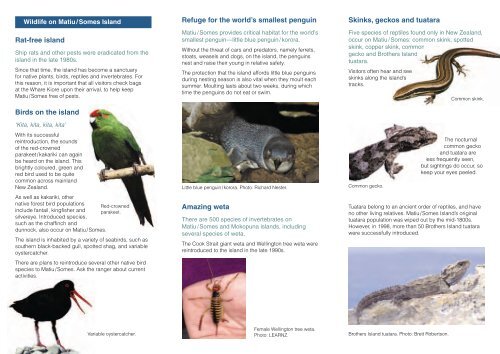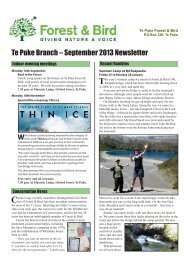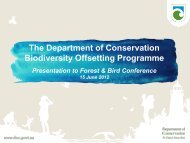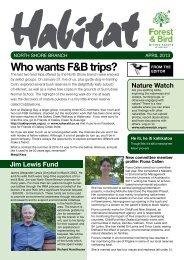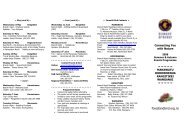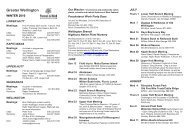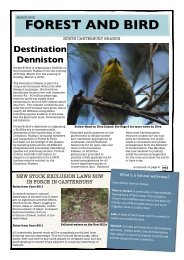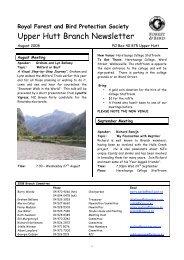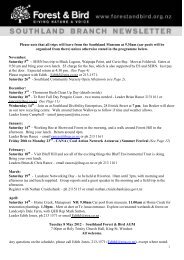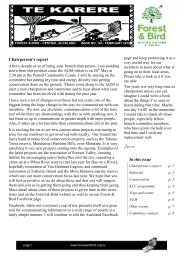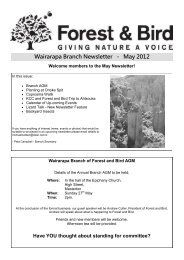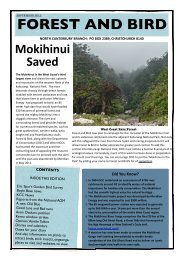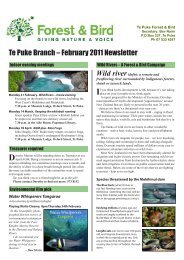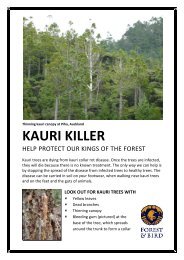Matiu / Somes Island - Forest and Bird
Matiu / Somes Island - Forest and Bird
Matiu / Somes Island - Forest and Bird
Create successful ePaper yourself
Turn your PDF publications into a flip-book with our unique Google optimized e-Paper software.
Wildlife on <strong>Matiu</strong> / <strong>Somes</strong> <strong>Isl<strong>and</strong></strong><br />
Rat-free isl<strong>and</strong><br />
Ship rats <strong>and</strong> other pests were eradicated from the<br />
isl<strong>and</strong> in the late 1980s.<br />
Since that time, the isl<strong>and</strong> has become a sanctuary<br />
for native plants, birds, reptiles <strong>and</strong> invertebrates. For<br />
this reason, it is important that all visitors check bags<br />
at the Whare Kiore upon their arrival, to help keep<br />
<strong>Matiu</strong> / <strong>Somes</strong> free of pests.<br />
<strong>Bird</strong>s on the isl<strong>and</strong><br />
‘Kita, kita, kita, kita’<br />
With its successful<br />
reintroduction, the sounds<br />
of the red-crowned<br />
parakeet / kakariki can again<br />
be heard on the isl<strong>and</strong>. This<br />
brightly coloured, green <strong>and</strong><br />
red bird used to be quite<br />
common across mainl<strong>and</strong><br />
New Zeal<strong>and</strong>.<br />
As well as kakariki, other<br />
native forest bird populations<br />
Red-crowned<br />
include fantail, kingfi sher <strong>and</strong> parakeet.<br />
silvereye. Introduced species,<br />
such as the chaffi nch <strong>and</strong><br />
dunnock, also occur on <strong>Matiu</strong> / <strong>Somes</strong>.<br />
The isl<strong>and</strong> is inhabited by a variety of seabirds, such as<br />
southern black-backed gull, spotted shag, <strong>and</strong> variable<br />
oystercatcher.<br />
There are plans to reintroduce several other native bird<br />
species to <strong>Matiu</strong> / <strong>Somes</strong>. Ask the ranger about current<br />
activities.<br />
Variable oystercatcher.<br />
Refuge for the world’s smallest penguin<br />
<strong>Matiu</strong> / <strong>Somes</strong> provides critical habitat for the world’s<br />
smallest penguin—little blue penguin / korora.<br />
Without the threat of cars <strong>and</strong> predators, namely ferrets,<br />
stoats, weasels <strong>and</strong> dogs, on the isl<strong>and</strong>, the penguins<br />
nest <strong>and</strong> raise their young in relative safety.<br />
The protection that the isl<strong>and</strong> affords little blue penguins<br />
during nesting season is also vital when they moult each<br />
summer. Moulting lasts about two weeks, during which<br />
time the penguins do not eat or swim.<br />
Little blue penguin / korora. Photo: Richard Nester.<br />
Amazing weta<br />
There are 500 species of invertebrates on<br />
<strong>Matiu</strong> / <strong>Somes</strong> <strong>and</strong> Mokopuna isl<strong>and</strong>s, including<br />
several species of weta.<br />
The Cook Strait giant weta <strong>and</strong> Wellington tree weta were<br />
reintroduced to the isl<strong>and</strong> in the late 1990s.<br />
Female Wellington tree weta.<br />
Photo: LEARNZ.<br />
Skinks, geckos <strong>and</strong> tuatara<br />
Five species of reptiles found only in New Zeal<strong>and</strong>,<br />
occur on <strong>Matiu</strong> / <strong>Somes</strong>: common skink, spotted<br />
skink, copper skink, common<br />
gecko <strong>and</strong> Brothers <strong>Isl<strong>and</strong></strong><br />
tuatara.<br />
Visitors often hear <strong>and</strong> see<br />
skinks along along the isl<strong>and</strong>’s<br />
tracks.<br />
Common gecko.<br />
Brothers <strong>Isl<strong>and</strong></strong> tuatara. Photo: Brett Robertson.<br />
Common skink.<br />
The nocturnal<br />
common gecko<br />
<strong>and</strong> tuatara are<br />
less frequently seen,<br />
but sightings do occur, so<br />
keep your eyes peeled.<br />
Tuatara belong to an ancient order of reptiles, <strong>and</strong> have<br />
no other living relatives. <strong>Matiu</strong> / <strong>Somes</strong> <strong>Isl<strong>and</strong></strong>’s original<br />
tuatara population was wiped out by the mid-1800s.<br />
However, in 1998, more than 50 Brothers <strong>Isl<strong>and</strong></strong> tuatara<br />
were successfully introduced.


